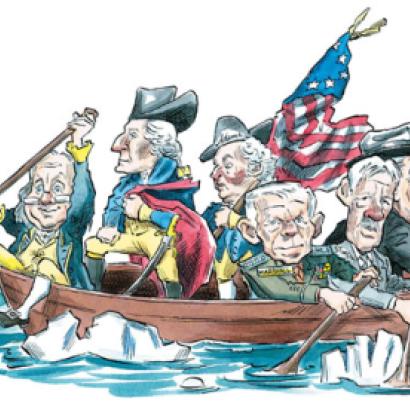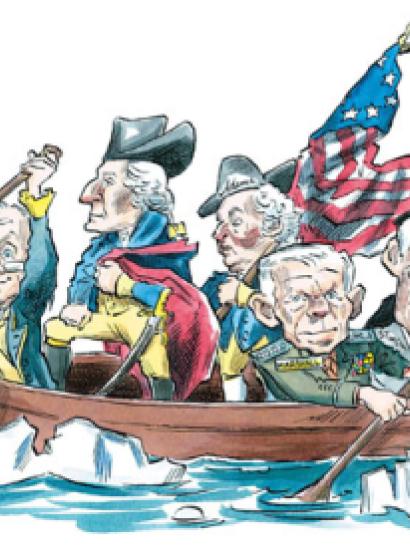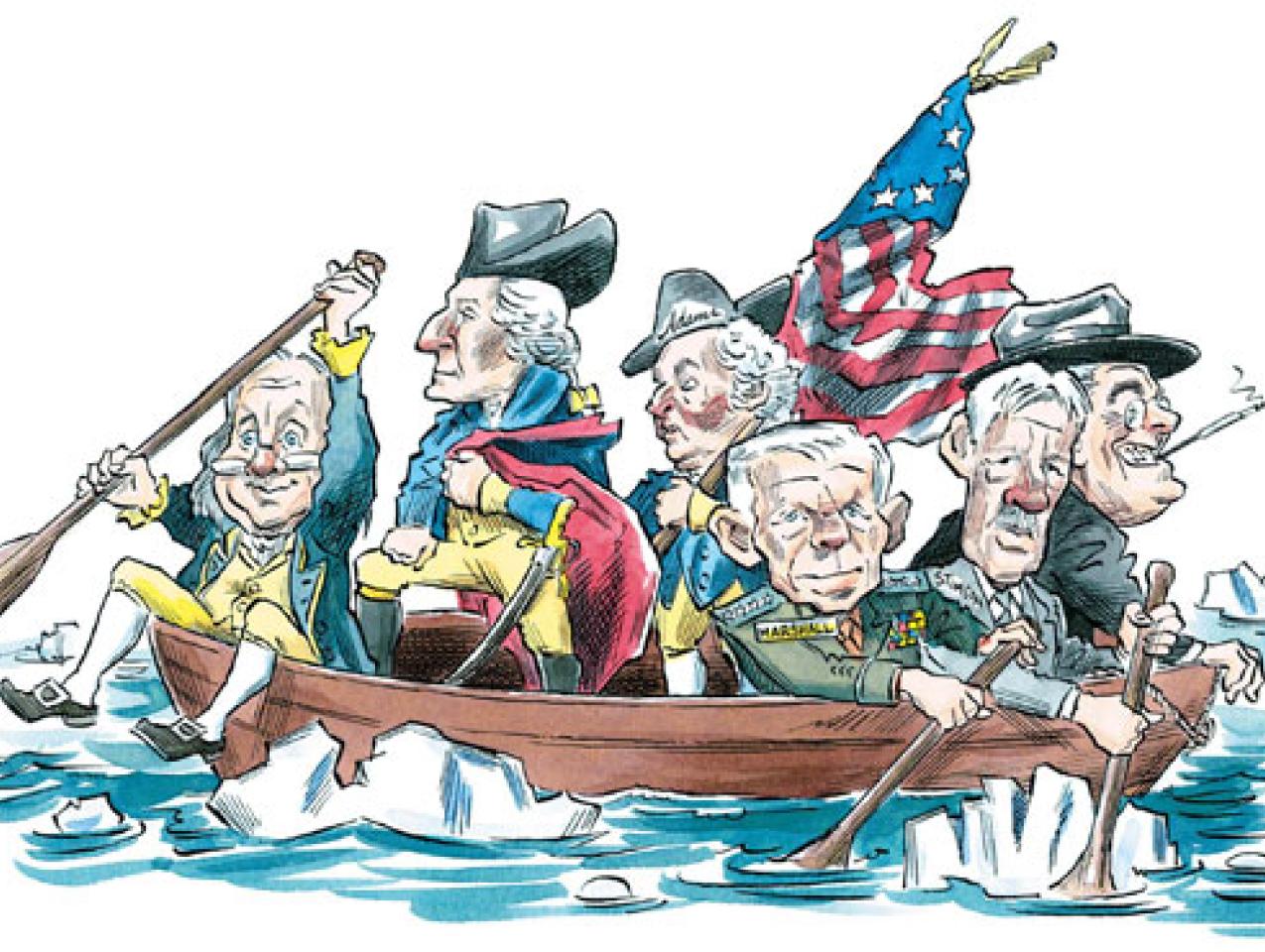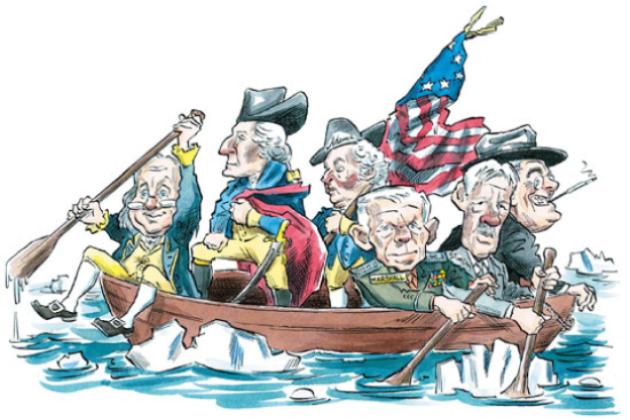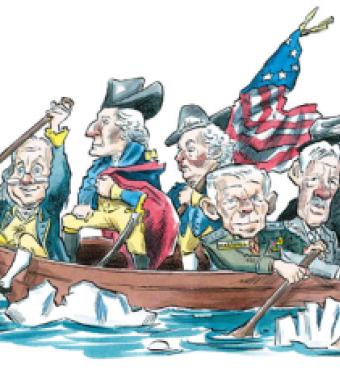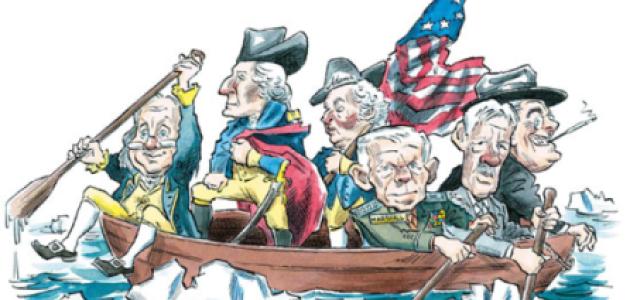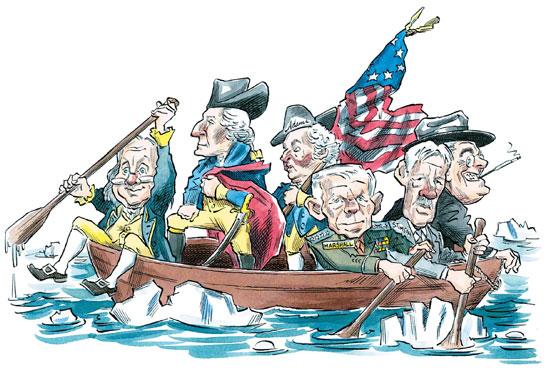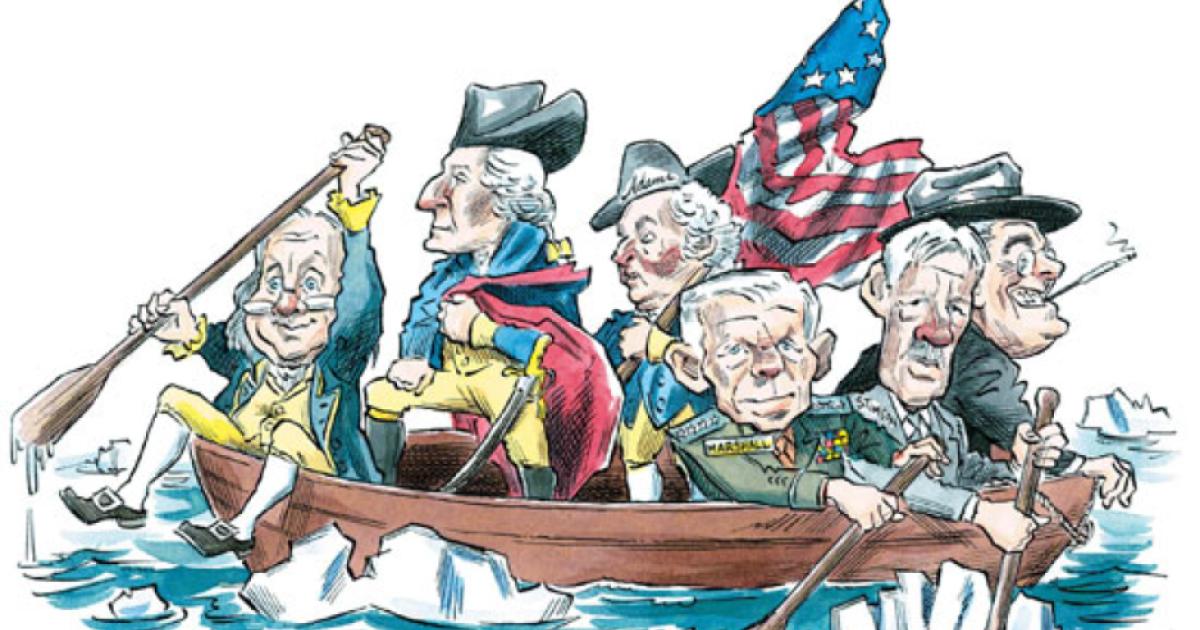- Security & Defense
- US Defense
- History
- Military
- US
Behind America’s elected leaders stands the civil-military nexus—the top civilian and military advisers to the president and Congress who offer strategic analysis, options, and recommendations. This decision-support activity is critical and not always effectively carried out. For example, the tenure of former defense secretary Donald Rumsfeld was rife with civil-military tension, characterized by Rumsfeld’s dominating approach toward the military and the acquiescence to it by senior general officers. The Pentagon’s leadership imbalance during those years is partially reflected in the difficulty the United States has had in achieving its strategic aims in Iraq.
Two celebrated American leaders—Generals George Washington and George C. Marshall—are role models in this regard, especially for today’s senior officers. They were seasoned, consensus-building officers who found ways to reconcile the civilian and military roles in national decision making. Their military careers offer many examples of the behavior appropriate to top-level officers as they help civilian leaders sort out the strategic environment and make weighty decisions on matters of national security.
Washington is rightly credited with first saving the revolution, and then saving the republic by squelching a conspiracy to impose martial law. In the immediate aftermath he returned his commission to Congress and subordinated the military to civilian control in the formative years of the nation. Marshall is held up as the twentieth-century paragon of civil-military virtue, with one scholar pointing out that Marshall was so committed to propriety and deference to civilian authority that he did not even vote, lest he be swayed by partisan leanings.
Those leaders deserve praise not just for military prowess but for setting an example for civil-military relations. Their overall conduct while leading armed forces, and the success they achieved in doing so, displays the virtue of preserving balance in that key relationship. Their careers portray military leaders and their respective political appointees as partners, all within a framework wherein elected civilian leaders always make the final decision.
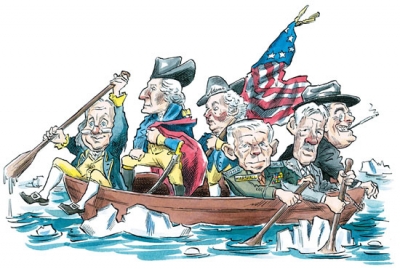
Washington and the Continental Congress
The civil-military relationships during our first conflict, the American Revolution, reflect a lively, sometimes contentious, but generally healthy dynamic between the Continental Congress and the commander in chief, Washington. As David McCullough relates in his book 1776, Washington was given broad powers and authority by Congress, often to such a degree as to make him uncomfortable. He was an avid reader of the classics, particularly Roman history and Addison’s rendition of Cato, and was deeply committed to the republican ideal and the attendant necessity for civilian control over the military. He made this plain in his correspondence with members of Congress.
Washington also was as professionally prepared as one could be at that time in America. As a young man, he had commanded military forces on the British side of the French and Indian Wars. He earned a strong reputation for courage and skill, although not all military endeavors he was involved with ended well. Washington was considered the consummate Virginia gentleman, was respected for his character and virtue, and was accepted as a peer by the members of the Congress as they convened in 1775. He was a delegate himself. He was competent, trustworthy—someone who could be counted on in the toughest of times. All of these characteristics shaped his interactions with the Continental Congress during his time as commanding general.
Unlike today’s civil-military arrangements, the general did not have the aid of a secretary of defense as he pursued military objectives for the Continental Congress and the American people. The position of secretary of war was not established until after the ratification of the Constitution. But members of Congress were not particularly concerned that military voices would dominate them; such fears seemed absurd in a period when no professional officer class existed. To be sure, there were strands of antimilitarism and significant opposition to a standing peacetime army. But even when the Founders later debated how to reform their government at the Constitutional Convention and the deliberations leading up to ratification, most were less concerned with keeping the military in its place than with avoiding political control of the military—that is, preventing one branch of the government from taking the reins of the army and turning it against other branches, the states, or the people.
As General Washington struggled with finding the way forward operationally in Boston in January 1776, assessing the strategic landscape among the colonies, he sought guidance from the Continental Congress on whether he should defend New York City. In his military assessment, he believed New York was critical, particularly the Hudson River, which if controlled by the British would split up the rebellious colonies. Yet he recognized that this strategic decision should be made by his civilian superiors. He appealed to Congress for direction.
The decision finally came when John Adams, a member of the Continental Congress, was home on leave in the Boston area in the winter of 1775–76. In a letter to Washington on January 6, 1776, Adams acknowledged that New York was critical and gave his consent to a military defense of the city.
In his letters to the American commander, Adams also tried to clarify the broad authority granted to the general, recognizing that Washington’s ability to be in constant contact with the Continental Congress could not always be guaranteed. Adams stated, “Your commission constitutes you commander of all the forces . . . and you are vested with full power and authority to act as you shall think for the good and welfare of the service.”
Washington immediately dispatched a senior officer to prepare the defense of New York City. The campaign would ultimately prove unsuccessful, with resounding defeats later that summer in Brooklyn and Long Island that required Washington to collaborate closely once again with Congress, this time seeking guidance on withdrawing from garrisons along the Hudson and what to do about the city.
As the end of 1776 approached, Washington faced a crisis. Enlistments were due to expire for nearly all of his troops within the next month, and the commanding general entreated his troops to re-enlist. With morale plummeting after the loss at Long Island and from lack of food and clothing, Washington contemplated his fate and that of the army. He reached a decision on how best to keep the army together: he needed to attack.
Washington did not need civilian guidance in this moment of crisis. He recognized that to do nothing was to see his army wither away. With no army, the cause would founder. Given the Declaration of Independence proclaimed earlier that year, Washington did not expect clemency from the British, nor was he asking for it. As Benjamin Franklin famously quipped upon signing the Declaration, “We must, indeed, all hang together, or most assuredly we shall all hang separately.” Washington understood Congress’s intent, and thus he exercised his initiative.
The attack was directed at the Hessian garrison in Trenton. On Christmas night, an army approximately 2,400 strong crossed the Delaware River and caught the Hessian force off guard. When the final assault commenced the next morning, the Americans quickly overwhelmed the defenders, killing about two dozen, wounding about 90, and capturing more than 900—with no American battle deaths, although two soldiers froze to death during the crossing of the Delaware.
This battlefield triumph, and the one that followed shortly after at Princeton, had a profound effect on the war. First, the victories lifted spirits in the army. It had atoned for its Long Island loss by winning stunning, lopsided victories. Victory also buoyed the morale of loyal Americans throughout the country, boosting recruitment for the Continental Army. Congress, too, greatly welcomed the news as it settled into its new location, Baltimore, after having fled Philadelphia the month before. But in the immediate aftermath of Trenton, Washington had another make-or-break battle ahead: expiring enlistments in his army.
Washington took considerable personal risk to keep his army intact, actually overstepping his authority by offering a $10 re-enlistment bonus (about two months’ pay) to troopers who agreed to stay six months beyond their commitment. This was risky because Congress had not approved such an offer; without authorization, there was no guarantee the promise would be honored. In explaining this to Congress, Washington tried to justify his behavior, citing the desperation of the moment, “I feel the inconvenience of this advance . . . but what could be done?” Fortunately, the gambit worked. Not only did many soldiers elect to stay on and fight for the cause, but Congress too saw the merit in such a move and authorized the bonuses.
Washington went on to command the field army for the remainder of the Revolution, seven more years. But 1776 was a seminal year, setting a precedent for the pattern of civil-military relations. All during his time as commander of the army, Washington would strike a balance between deference and accountability to his civilian superiors in Congress, and initiative to act without orders when his civilian superiors were unavailable to render a decision. Even when he acted unilaterally, he was faithful to Congress’s intent. The Continental Congress trusted his judgment, and the general proved time and again that its trust was well placed.
With Washington we see the foundational example of how military commanders should conduct themselves within a democratic system: leading forces in the field to achieve political ends; constantly seeking clarification at the nexus of political-military operations and decisions; and aggressively pursuing the fight and strategic objectives. Washington was accountable for the success or failure of military operations. To be sure, he was not without critics, even within Congress, during the eight years he led the army. Yet the people’s representatives had access to him, were able to provide guidance and set limits, and held him accountable for achieving their aims. And the citizens ultimately saw that their national security goals were met. The civil-military relationship provided a foundation for victory during the Revolutionary War.
Marshall and Secretary of War Stimson
Scholars often cite General George C. Marshall as the classic example of a stoic, apolitical military officer who subordinated himself to civilian control. Indeed, a careful review of his long and varied career confirms Marshall’s unswerving commitment to civilian control of the military, yet he was more than up to the task of aggressively representing the profession in the civil-military nexus. His voice, advice, and judgment always resonated, even as he loyally executed the orders of the president.
Marshall enjoyed a diversity of assignments: multiple postings in front-line infantry units, stops for an advanced degree and teaching jobs, and positions where he helped administer large civilian organizations like the Civilian Conservation Corps before World War II. This variety affected his worldview and helped him work well with people of different cultures and in a range of federal and state agencies. It certainly prepared him for positions of high authority and responsibility during World War II. Marshall developed a keen understanding of how military organizations could help the country reach policy objectives, both foreign and domestic, and maximize human potential. When he worked with civilian authorities, his conduct was controlled, respectful, and obedient—yet decidedly determined. His career offers many examples of aggressive advocacy and bureaucratic clashes, even with cabinet-level appointees and the president himself.
Secretary of War Henry L. Stimson (a conservative Republican from President Roosevelt’s home state of New York, serving in the most liberal Democratic administration up to that time) was his civilian counterpart. Stimson and Marshall had a healthy relationship and together they advanced the war effort. Although a 1939 executive order authorized Marshall to communicate directly with the commander in chief on issues of “strategy, tactics, and operations,” Marshall wisely chose otherwise and consistently worked with his secretary of war.
Marshall clearly saw the advantage of uniting with his civilian chief, who, besides being a member of the cabinet, was also a member of the opposition party in Washington. But their personal relationship, which was a couple of decades old by the time World War II broke out, was not without conflict, and how these men handled themselves during those moments provides helpful examples for today’s top civil-military leaders.
On some important issues—for instance, the training and commissioning of officers needed to fill the ranks of the burgeoning forces, and then later how best to allocate intelligence resources—Marshall disagreed strongly with proposals by the secretary of war, and in both cases, Marshall’s position prevailed. On the training and commissioning of officers, Stimson favored cultivating college graduates through civilian training camps, similar to what had been done during World War I. Marshall wanted more of a focus on Officer Candidate School (OCS), which would draw heavily from the most promising members already in the service but leave open officer training for college graduates after they had enlisted and served for a time. After much wrangling, Stimson ceded the point, but not before Marshall threatened to resign if he were overruled. Marshall later regretted this action. Looking back, he saw his threat as inappropriate for the nation’s military chief during deliberations among top advisers to the president.
Later in the war, when Stimson believed that the Army should reassign some of its intelligence experts from its seasoned divisions to seed new ones, Marshall strenuously objected, concerned about diminishing the combat capability of units already committed in the European and Pacific theaters at a pivotal time in the war. Stimson eventually saw the merit in Marshall’s views and dropped the idea.
There were, of course, times when Marshall acceded to Stimson’s positions. Marshall and Lieutenant General Leslie Groves, military director of the atomic bomb project, bowed to Stimson’s wishes when the bomb’s target list was drawn up. Stimson objected to the inclusion of Kyoto, a major Japanese cultural center, and overruled Groves, who wanted that city included. Marshall chose not to support his general but to accept Stimson’s decision.
Stimson, like Rumsfeld years later, was on his second tour as the leading civilian overseer of the military when he served as a U.S. war minister. Stimson had been secretary of war during the Taft administration in 1911–13. One point to single out from his long career is his Army service in the First World War, in which he volunteered for active duty and rose to the rank of colonel in the artillery. He enjoyed a strong reputation as a bright, professional, problem solver and a personable leader.
General Marshall respected and admired Secretary Stimson. It is important to be clear about the relationship between Marshall and Stimson because scholarly literature today leaves an impression of Marshall as always deferring to civilian control—implying that he would have been a harsh critic of General Colin Powell and the active role Powell played in the civil-military nexus, and that Marshall would have been submissive to domineering secretaries of defense like Robert McNamara and Rumsfeld. My reading of Marshall’s record leads me to a contrary conclusion.
Marshall believed that military officers should be accountable and obedient to the president and Congress, the nation’s elected leaders. Holding the democratic process in high regard, he believed that elected leaders were to be publicly respected by military officers. But he also believed that the nation’s top military officer should work together with the nation’s top political appointee to best serve their elected superiors and the American people. Thus at times he was privately very vocal, advocating and representing his profession during national security deliberations. He could be aggressive even with President Roosevelt. Forrest Pogue, Marshall’s official biographer, described the general’s protestations over Roosevelt’s desire to give New York Mayor Fiorello LaGuardia a direct commission to brigadier general. Marshall viewed this as unwise and teamed up with Stimson to talk the president out of it. (In the end they persuaded Roosevelt to offer the mayor a commission as a colonel—an offer LaGuardia declined.)
In public, Marshall’s commitment to civilian control of the military led him to support Roosevelt’s decision to invade North Africa, although he privately disagreed strenuously with that decision, preferring instead to focus on recapturing Europe at the earliest time possible. Many times Marshall also supported the president’s personal requests for officer promotions, including Roosevelt’s son, although he had reservations.
Marshall had a long and distinguished career, serving as secretary of defense and state after retiring from the military. His later years also contain many examples of productive civil-military relations of the kind he established with Stimson: free of any insecurity pervading their joint role and of any excessive concern for matters of protocol. Each man knew his role individually and what was possible of them collectively. In this system, General Marshall was expected to provide his best military advice. Even when the president overruled him, the system was working.
The last point perhaps explains why there was no outcry over Marshall’s influential role in national security decision making during World War II. The most obvious feature of the Marshall-Stimson dynamic—periodic friction but abiding and mutual respect—is that it worked. The United States won the war.
Generals Marshall and Washington could point to records of both military success and functional relationships with their civilian counterparts and superiors. And their examples indicate how military officers today should interact with the president, Congress, and political appointees at the Pentagon.








